Comments from the Chair
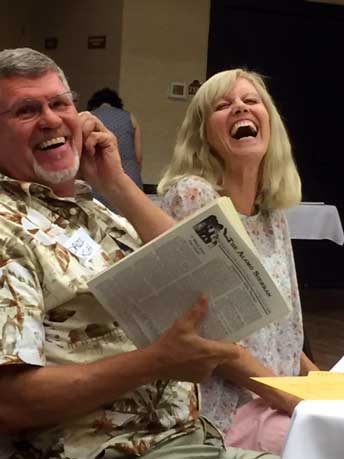
A great 50th anniversary celebration
Our Alamo Group 50th Anniversary celebration was a success! Many thanks to Jerry Morrisey, Loretta Van Coppenolle and others for much organizing work, and to Laurel Heights United Methodist Church for providing us a fine venue to gather for this important milestone. The Alamo Group has a long history of successfully striving to improve our local environment.
The present and future continue to confront us with major environmental challenges, from climate change, to clean air, water resource management, growth management and more. Our 2,800 members in all of SA and surrounding areas have many opportunities to help out here locally and beyond.
See more party pictures below.
Making a good City budget and climate plan
City of San Antonio (CoSA) is in the midst of its FY2019 Budget approval process. We are working for a budget that advances our environmental and climate change priorities. Please learn more on line and get involved in the budgeting process.
At our August 21st general meeting, Austin Sierra Club scientist Bruce Melton gave a very good presentation about current climate change science. You can learn more about his unique perspective on his website.
We remain heavily involved with the CoSA Climate Action & Adaption Plan (CAAP) process. We are working with other groups, especially through our local Organizer Greg Harman, to build support for a comprehensive, equitable, strong CAAP. SA Climate Ready is an excellent resource for learning about the CoSA’s CAAP process and how to get involved. We are members of the Climate Action SA coalition and its website provides an overview of our climate efforts and goals.
We are meeting with City Council members to discuss our budget and environmental priorities for San Antonio and are in discussions with CPS and SAWS Board of Trustees members about our environmental priorities.
If you live the Southwest quadrant of the city, please consider tossing your hat in the ring for appointment to the CPS board.
Bexar County ozone levels officially exceed safe levels
In July, the Environmental Protection Agency (EPA) officially designated Bexar County as being in “Non Attainment” for ozone, leaving surrounding counties as “Attainment/Unclassifiable”. Some officials are talking of lawsuits or other resistance to fight this clearly appropriate designation for Bexar County (the exclusion of surrounding counties in our Metropolitan Statistical Area (MSA) is, on the other hand, unprecedented).
We now have until the end of 2020 to institute programs and regulations that achieve, by that date, attainment of 70 ppb, or below for ozone monitor levels, per Clean Air Act standards. For a better understanding of these issues, I recommend these resources :
- The presentation by Steve Dayton of TCEQ, which includes a section titled Volkswagen Environmental Mitigation Trust for State Beneficiaries. This will be of interest regarding the goal for the settlement funds to "Prepare for Increased and Sustained Use of Zero Emission Vehicles." The San Antonio area is considered a "primary area" for settlement funds distribution and is currently slated to receive $73,554,754 or 35.14% of the total allocated to Texas.
The Alamo Area Council of Governments (AACOG) looks to be the primary regional administrator regarding funding distribution.
For further information, view the Texas Emissions Reduction Plan & VW Update [TCEQ, Steve Dayton; AACOG AQ Committee, August, 2018]. - The presentation by Brian Foster and Donna Huff of TCEQ, which was the first presentation by the State of Texas providing the outlines of the planning process which the state will direct due to the recent Non-attainment Designation for Ground-Level Ozone by the Environmental Protection Agency.
See San Antonio Area Update: 2015 Ozone NAAQS [TCEQ, August 22, 2018; AACOG AQ Committee]. - Other materials provided during the Air Quality Committee meeting available in Agenda, AACOG Air Quality Committee Meeting, August 22, 2018; AACOG AQ Committee [183 pages].
Special thanks to Peter Bella for the above comments and links. I have huge reservations about $73.5M going to AACOG for them to disburse.
After the Governor vetoed AACOG funding for air quality work 1 & 1/2 years ago, AACOG quickly shut down their activities, some of which were rescued at the last moment by CPS and CoSA. AACOG historically is an organization dominated heavily by surrounding counties that include serious climate change deniers, anti-science and anti-CoSA officials.
It is Bexar County, and so mainly CoSA, that has the non-attainment problem, not any surrounding areas represented in AACOG. I have heard CoSA officials, especially our excellent Director of Metropolitan Health Dr. Bridger, speaking about plans to address our non-attainment. I have heard nothing from AACOG. Metro Health and Sustainability Departments of CoSA already have funding requests to address some of these issues. I believe these funds should go from TCEQ directly to CoSA, Bexar County, and possibly AAMPO, the latter two dealing with some of our sprawl and mobility issues contributing to ozone.
Learn more at the Texas Volkswagen Environmental Mitigation Program page. Submit comments on or before October 8 to VWSettle@TCEQ.texas.gov.
It's election season
Our Political Committee is gearing up for very active involvement in fall state and national elections. And the Sierra Club Political Committee of Texas has posted its full slate of endorsements at TurnTexasGreen.org. You can read more about the great work we're doing in Sierra Club Announces First Round of 2018 Texas Legislative Endorsements.
Better ways to travel
We are working with local organizations like Bike San Antonio, the Alamo Area Metropolitan Planning Organization, and its Bicycle Mobility Access Committee and Pedestrian Mobility Access Committee to expand safe bike lanes and pedestrian mobility around town.
Climate, Jobs & Justice rally
There will be an international Climate, Jobs and Justice rally held here in San Antonio under our sponsorship, on September 8. Volunteers are need to help. See the announcement below.
The Alamo Group wants you
It is not too early to think about joining our Executive Committee (ExCom). This is the group that provides overall direction to our Alamo Sierra Club. Anyone who has been a member for at least six months can run for election to our ExCom.
Terms are for three years, and the ExCom meets monthly, second Thursday evening of each month. We welcome and need new members. Visit our website to learn more.
Keeping you informed
I will be transitioning my “Eco Calendar” alerts, currently sent to 50-70 activists for whom I have emails to focusing more on wider reaching Alamo SC email alerts and more frequent updates on the Alamo Group's website. Please check us out there regularly.
by Terry Burns, M.D., Alamo Group Chair
#SATX Rise for Climate, Jobs & Justice
On September 8, the Alamo Group of the Sierra Club will join thousands of rallies being held in cities and towns around the world to demand our leaders commit to building a fossil free world that works for all of us.

Saturday, September 8th
11 a.m. to 2 p.m.
Milam Park, 500 W Commerce St
In San Antonio, the climate justice movement has already inspired our mayor and council to launch a climate action plan for the city. We can celebrate that commitment but we can't equivocate: San Antonio must declare our commitment to getting off fossil fuels entirely.
We must develop together a climate plan that prioritizes the needs of those who are most at risk from rapid climate change—communities who have been too long marginalized and disempowered. As we re-create our economy based around sustainable principles, we are calling for jobs with justice for all.
For information about this event, contact Greg Harman, Sierra Club San Antonio Clean Energy Organizer, or visit the event's page on The Action Network or visit Rise for Climate.
Who Owns CPS Energy?
Decision to exclude nearly 40 percent of CPS Energy emissions from evolving Climate Action & Adaptation Plan revives long-standing debate
The seats are pulled up in a large circle at Esperanza Peace & Justice Center as so often happens in activist spaces. Nuclear power. Community organizing. Solar deployment. Green spaces. Climate destruction.
All things energy are on the table at Climate Action SA's first community conversation—a climate plática—about City-owned CPS Energy's vision for the future.
“What do you mean that windmills are the same as gas plants?” asks one participant of another, digging into one more brief debate, intended to target local relationships with energy and energy justice.
Coal until 2042?
The event is inspired by the recent release of CPS Energy's “flex plan,” suggesting coal power to 2042 and possibly beyond and a remarkably slow investment in new renewables (the soonest serious investment occurs in solar is in the mid-'30s). It's a vision the Alamo Group of the Sierra Club has come out strongly against.
While the council and mayor were invited to the event, only John Courage (Council District 9) is among us—without doubt one of the most progressive and accessible councilmembers. After patiently listening for more than 30 minutes, Courage offers that City Council has very limited control over CPS Energy. “All we can do is approve their rate increase requests,” he says.
He's not alone in his misunderstanding of the relationship between the City and the utility it purchased in 1942. And that has begun to cause complications in the Climate Action & Adaptation Plan (CAAP) process.
Last summer, the San Antonio City Council announced it would pursue a pathway to meet the non-binding international Paris Agreement. The hope: That even without the support of the U.S. President, the rest of the nations of the world—and committed U.S. cities and states—would hold global temperature rise to under two-degrees Celsius.
In July, climate planners presented volunteer members of the CAAP steering committee and various technical working groups a plan to catalogue existing emissions. We were creating a target, so we knew how much emissions needed to reduce to meet our required contribution to “meeting Paris.”

City claims no "operational control" of CPS
One problem leapt to the fore; nearly 40 percent of CPS Energy's 11.34 million tons of annual greenhouse emissions were not included in that inventory. (Over a million tons of emissions from private industry, also initially excluded have since been added back, thanks to strong pushback from the various CAAP citizen working groups.)
The Navigant consultant guiding the process explained the decision by saying that attorneys for the City and CPS Energy, and the Office of the Mayor had agreed to the exclusion. Among the justifications for exclusion is the suggestion that San Antonio doesn't have “operational control” over the utility it owns—and certainly not the 37 percent of the power it sells to communities outside City limits.
This assertion, by representatives of the Office of Sustainability and Navigant Consulting, cuts to the heart of long-standing community grievances over how the utility is—or rather, is not—managed. To smooth anticipated agitations, the draft emissions inventory stated: "CPS Energy will track emissions for their broader service area and will have comprehensive initiatives to reduce emissions to benefit the entire area." It was an accounting recommendation met with skepticism by some steering committee members.
“To keep with Paris on a global scale, I don't know how relevant the City of San Antonio's boundaries are," steering member Peter Bella said. “I consider CPS Energy owned by the City and operated by the City.”
CAAP managers seemed to be going against best practices defined by some greenhouse protocols, such as the US Community Protocol, which requires inclusion of "all emissions from energy production and energy use in energy industries," as well as “all emissions from the generation of energy for grid-distributed electricity, steam, heat and cooling.” The top three questions the Protocol asks cities to consider when identifying areas over which they have most influence, include: Do I own it? Do I have operational control? Do I have regulatory authority over it?
The lack of transparency and community engagement at CPS Energy have been sore points for clean energy advocates and social and environmental activists for decades. So, in many ways, this question of emissions is a perfect opportunity to hash that out.
CPS's management structure explained
Let's start with the broad strokes of this power dynamic at Texas Government Code Section 1502.070, “Management and Control of Utility System.”
There we see that while CPS is indeed a City-owned utility, day-to-day management and many other key tasks are assigned out to an appointed Board of Trustees, composed of four members and San Antonio's sitting mayor.
This Board appoints and manages CPS Energy's executive officers—the CEO, COO, various VP's, etc. Like a corporation, the CEO and management oversee day-to-day operations. The Board receives regular reports from management and holds monthly meetings.
However, it is the San Antonio Antonio City Council that appoints those trustees and defines the scope of their duties and authority. It is the San Antonio City Council that controls utility rate adjustments, the issuing of bonds, decides cases of eminent domain, and sets policy at a broad level.
It is the City that placed power in the hands of a Board of Trustees—power they can also take away. If sufficiently motivated, the Council could adopt an arrangement whereby the City Council becomes the Board of Trustees, such as is practiced in Austin.
San Antonio City Ordinance:
The Board of Trustees, in exercising the management powers granted herein, will ensure that policies adopted affecting research, development, and corporate planning will be consistent with City Council policy, and policies adopted by the Board of Trustees pertaining to such matters will be subject to City Council review.
It could be argued that the board arrangement, often used to define the utility's distance from the Council, is actually an tool of “operational control” on behalf of the City. It is indisputably the Council that leads in this dance.
Sustainability coalition recommends broad accounting of greenhouse emissions
If San Antonio Mayor Ron Nirenberg declared tomorrow, “We're taking San Antonio to net-zero carbon on all energy generation by 2030,” CPS would be forced to swing into action. The U.S. Community Protocol for Accounting and Reporting of Greenhouse Gas Emissions, suggests time and again that cities go deep and broad with estimating climate emissions.
It is anticipated “but not required” that cities like San Antonio focus their work on “emission sources and activities over which they have significant influence.” They may also choose to widen their scope to those areas they don't have regulatory authority over—such as “emissions that result from activities such as the use of energy, materials, and services by all members of the community. These emissions may be occurring within or outside of the community boundary.”
ICLEI, which developed that protocol, is skeptical of decisions to leave out these broader emissions, since failing to do so “provides a much less complete story of how the community contributes to climate change, as many community activities ... contribute to emissions from trans-boundary sources.” ICLEI, is an acronym for the International Council for Local Environmental Initiatives, now known simply as Local Governments for Sustainability.
Perhaps operational control is in the eye of the beholder. More likely, historical “misunderstandings” have simply served a council that likes to take refuge in the shelter it allows.
Replacing coal is critical
While adjustments have been made in response to feedback on the initial inventory, such as roping in the massive emissions from the cement batching plants, the CPS matter remains as it was. In this, the generators of the “flex” plan, and those suggesting the lack of operational control, are saying: “Trust us.” Those laboring for a clean-energy future, such as the many volunteers at the Sierra Club, aren't waiting for the utility to report back.
We recognize we are morally obligated to do everything we can to slow and reverse climate change for those families being devastated by increasingly violent weather events right now and for those generations to come who we have already overburdened with an existential challenge. To accomplish this, we must clearly identify the largest culprits, the coal and gas plants powering the city, as well as the cement kilns, gas-guzzling transportation, military bases, and our landfills.
Barring that, without a clear target, there is no way to know at what point our effort has been successful—that we have achieved, indeed exceeded, localized Paris-level reductions.
Given that uncertainty, the Sierra Club's campaign to eradicate San Antonio's worst offender—CPS coal power—by 2025 becomes even more critical. From there we can move confidently to a net-zero energy sector by 2030. All the while, this shift from an extractive polluting economy must advance and evolve in San Antonio until we are not only not polluting, where we absorb more greenhouse pollution than we emit, but grows a just and regenerative economy serving all our residents.
This is the justice vision at root in Paris and one that must be tended and cultivated in San Antonio consistently all along the climate action process.
by Gregory Harman, Lone Star Sierra Club organizer and CAAP Steering Committee member.
Great Smoky Mountains National Park
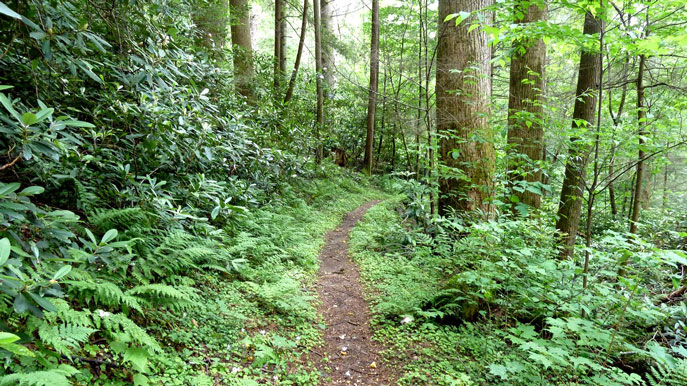
A closing observation
"For every far-seeing conservationist, there have been scores or hundreds of short-sighted practical persons who thought that we should be satisfied with a small number of areas which in narrow boundaries preserved specific scenes or wonders of nature. They lost sight of the need for spacious areas, if the wilderness, with its endowment of plant and animal life, is really to be preserved as more than a museum piece."
By Horace Albright, second Director of the National Park Service, 1929-1933. Quoted in a limited circulation newsletter published by former National Park Service staff, March 2018.
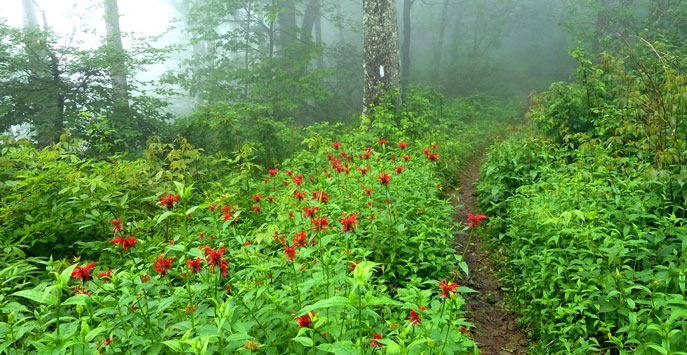
by Kevin Hartley, Alamo Group Outings leader
Say No to Nuclear Waste being Transported through Texas!
We need to be ready for September protests and public comment
It’s back!... Waste Control Specialists (WCS), the company that, in 2014, had then-Governor Perry as its champion for federal approval to build a temporary repository in far West Texas for low-level radioactive waste, is now back in the competition to become a temporary centralized repository for all high-level radioactive waste in the U.S. It now has competition from Holtec, a company that proposes to build the repository right across the border from WCS in New Mexico.
Either way, if approved, such a “temporary” repository would result in thousands of casks of extremely dangerous “spent” fuel rods being shipped by train through Texas cities to languish in a facility not built to standards for a permanent repository. If the Nuclear Regulatory Commission (NRC) accepts the preliminary application, we will have only 60 days to submit public comment and to get public attention to fight it.
Expect an event in San Antonio on or around September 26th. As soon as details are available, we’ll post them on the Alamo Group website calendar.
In 2016, Bexar County went on record as against the shipment of high-level nuclear waste, but cities and counties have no real power to protect their citizens on this issue. The main decision is up to the NRC, which is why our public comments are so important.
Last May, however, the House of Representatives passed HR 3053, a bill that prevents barriers to storing high-level radioactive waste in Texas and New Mexico. Many thanks to Texas Representatives Joaquin Castro, Lloyd Doggett, Al Green, Sheila Jackson Lee, and Beto O’Rourke, as well as New Mexico Representatives Michelle Lujan Grisham and Ben Ray Lujan for voting against HR 3053.
This is not a partisan issue. No Republican or Democrat should welcome a “temporary” facility that could contaminate aquifers and oilfields with high-level radiation. For more information, see the No Nuclear Waste website.
by Meredith McGuire, Conservation Committee Co-Chair
John Winkler, an American Etcher
The 50th celebration of the Alamo Group of the Sierra Club emphasized the many accomplishments of the group. I am a long time member who grew up hiking in the high Sierra Mountains.
My step-father, John W. Winkler, used to hike with Bill Colby, one of the founders of the Sierra Club. I brought to the meeting one of "Wink’s" original etchings, “Ritter and Banner”, which was the inspiration for the Sierra Club logo.
Jerry Morrisey suggests that I donate the original to the headquarters in California. Anyone interested in having a copy of this etching, please contact me.
I also brought a copy of the book on Mr. Winkler. It is an interesting story of a renaissance man from Vienna who recorded the beauty of nature in etchings, drawings, carved wooden boxes and jewelry. I have copies of the book for anyone interested.
Mr. Winkler’s work can be explored on his website. For more information contact Carol Johnson, (210) 647-6099.
by Carol Johnson, Alamo Group member
Alamo Group 50th Anniversary Celebration

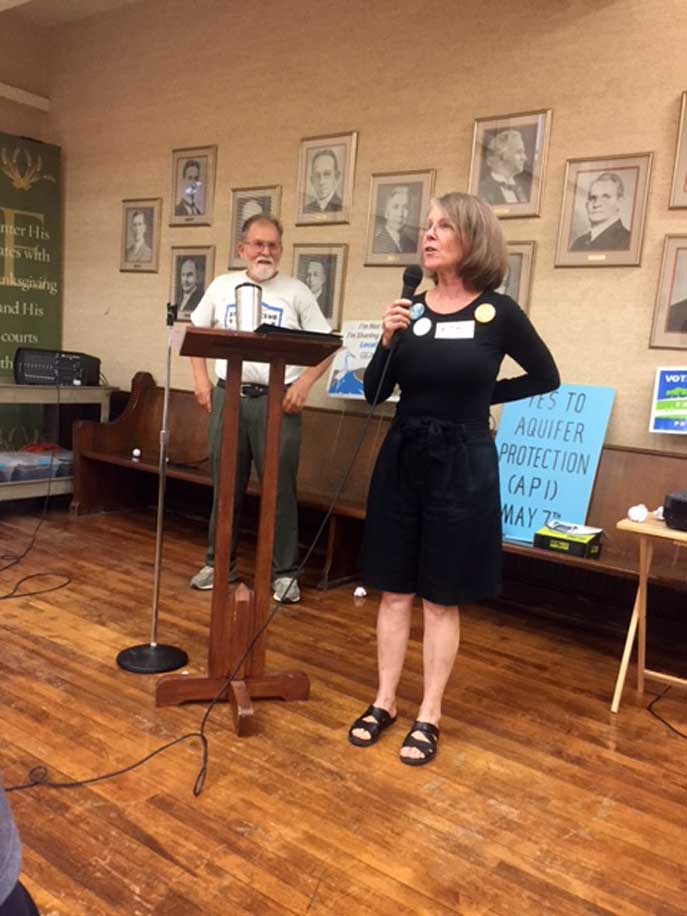
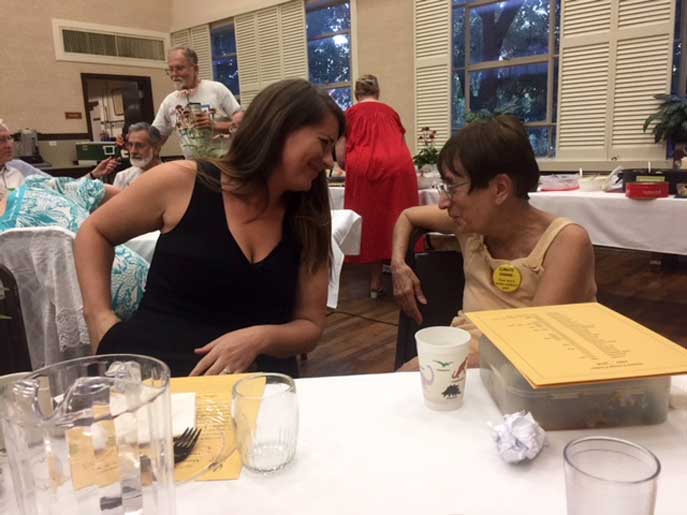
by Carolyn Wells, Alamo Group member
Saving San Antonio's Oaks
Trees breathe, trees have vibrations, trees travel, trees shade (cool the air), trees help us breathe, trees decorate, and more. Trees are our canopy. They provide wood (for fire, furniture, buildings) and fruit and nuts, and seeds. Trees are our friends. Trees have energy.
This past year, a film was shown at the Headwaters describing how a disease is passed, how it travels, and how it can devastate an entire region. An unpainted branch can have exposure for seventy-two hours, and the disease has been known to kill thousands of trees within five to seven weeks.
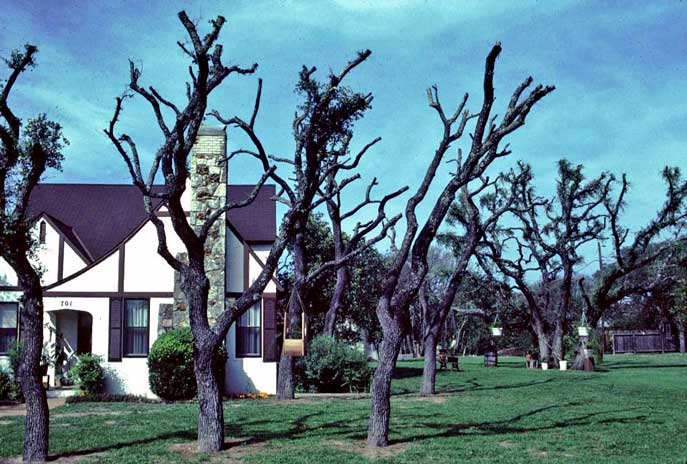
Oak wilt is a terminal disease of trees caused by beetles and fungus. It travels to unpainted branches (sometimes trucks cause this) and through roots. Oaks have communal root systems and the disease can travel underground as well. Miles of oak wilt have spread in the Hill Country northwest of San Antonio/Bexar County.
What to do?
- Paint all tree branches after cutting. ( Many will recommend painting specific trees at specific times) To be on the safe side, paint all tree branches after cutting.
- Bring no firewood to San Antonio/Bexar County. (Some will suggest that firewood be placed on plastic.) However, all areas of identified oak wilt in Bexar County have been traced to firewood brought in, which, in turn exposes roots to Oak wilt. Keep in mind, there are those who will remove infected wood and bring it to the city for a low price.
- Clean trimming equipment with household detergent.
- Use only licensed tree trimmers. Take a picture of their license with your phone. And check local government licensing programs for a verification.
- Plant diverse species aggressively. This will reduce the risk of a single species being lost.
Two critical questions
- What is the dollar cost of oak wilt?
- What is the rate of spreading in our region?
Stay tuned. Remember: oak wilt is an ongoing problem. Join your neighbors (us) in protecting trees. In some respect, this message is brought to you by trees. Help.
by Arthur Dawes, (210) 213-5919
Miss a Meeting? Watch the Video on Social Media
If you aren't able to join us at one of our meetings, you can experience the next best thing through videos on our Facebook page. You can watch our two most recent meetings at the links below. And be sure to share with your friends and get the word out about these important issues.
CAAP: Feeding a Local Food Revolution?
Rising temperatures, stronger storms, depleting global fertilizer supplies all mean extractive industrial agriculture is going to take a big hit from climate change. As the City's first climate plan percolates, a local foods revolution continues to quietly gather steam in San Antonio.
Join us for a conversation with some of the leaders of the local food movement. Watch the video featuring Mitch Hagney (LocalSprout Food Hub), Kate Jaceldo (Compost Queens), and Nadia Gaona (San Antonio Permaculture).
Bruce Melton: Climate Discovery
Austin Sierra Club Climate Scientist Bruce Melton presents some of his work documenting Climate Change. Mr. Melton is a registered professional engineer, environmental researcher, author, trained outreach specialist, critical environmental issue filmmaker and front man for the band Climate Change.
His work with climate started in the early 1990s when he was principal investigator for an EPA / Clean Water Act grant studying stormwater runoff treatment. Familiarity with the industry of science allowed him to begin following the growing body of ice research from Greenland and other new fundamental climate science that was redefining climate change.

Outings: The Call of the Wild
Visit the Alamo Sierra Club Outings page on Meetup for detailed information about all of our upcoming Sierra Club Outings.
The Alamo Sierran Newsletter
Richard Alles, Editor
Published by The Alamo Group of the Sierra Club, P.O. Box 6443, San Antonio, TX 78209, AlamoSierraClub.org.
The Alamo Group is one of 13 regional groups within the Lone Star Chapter of the Sierra Club.
Keep your email address current!
Send updates to Loyd Cortez, providing your name, address and membership number (if known).
Changed your mailing address?
Have you moved? Let us know by sending your old address, your new address and your member number (look on the upper left corner of your mailing label) to: address.changes@sierraclub.org.
Go online for the latest news and events
 |